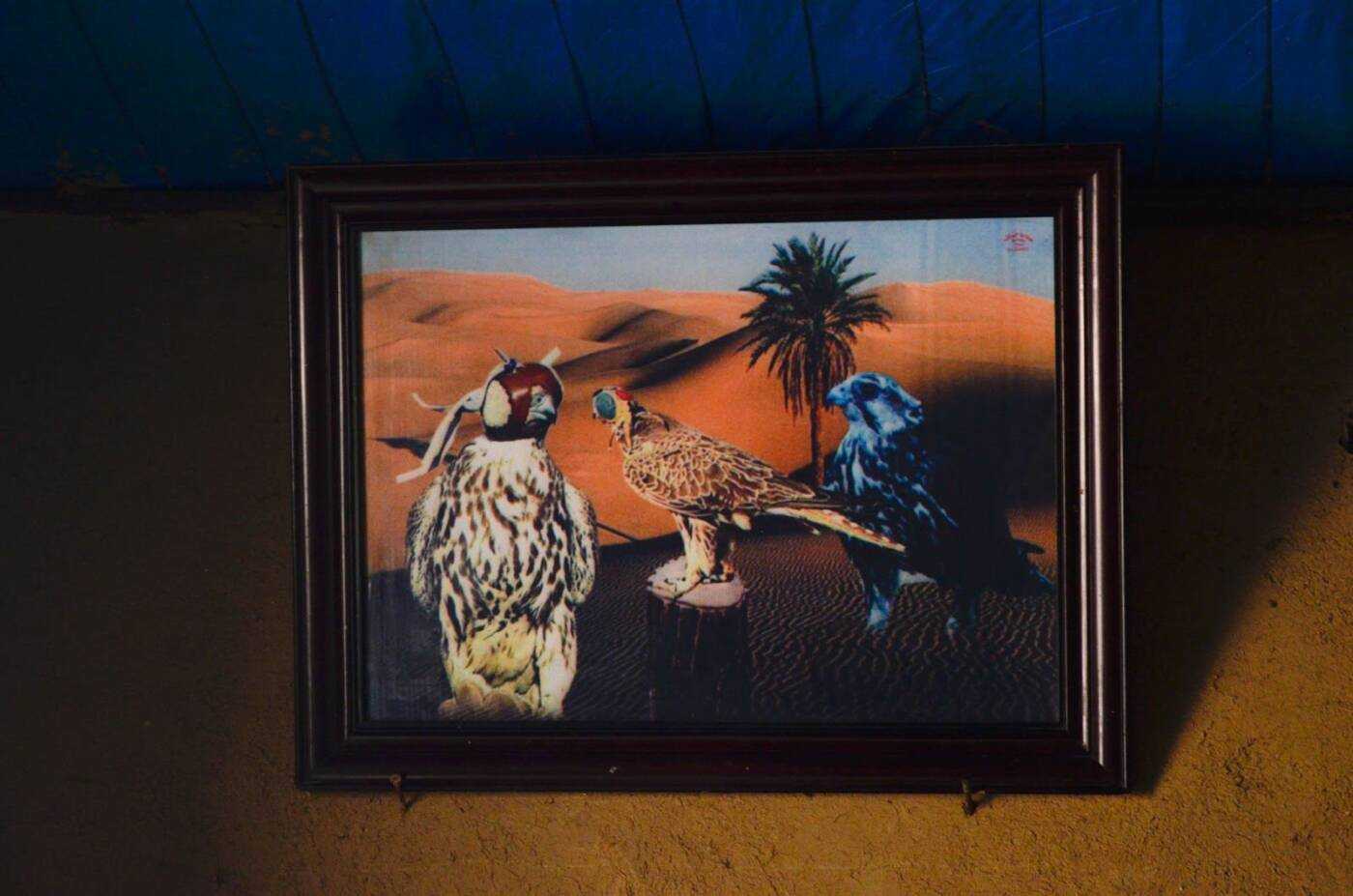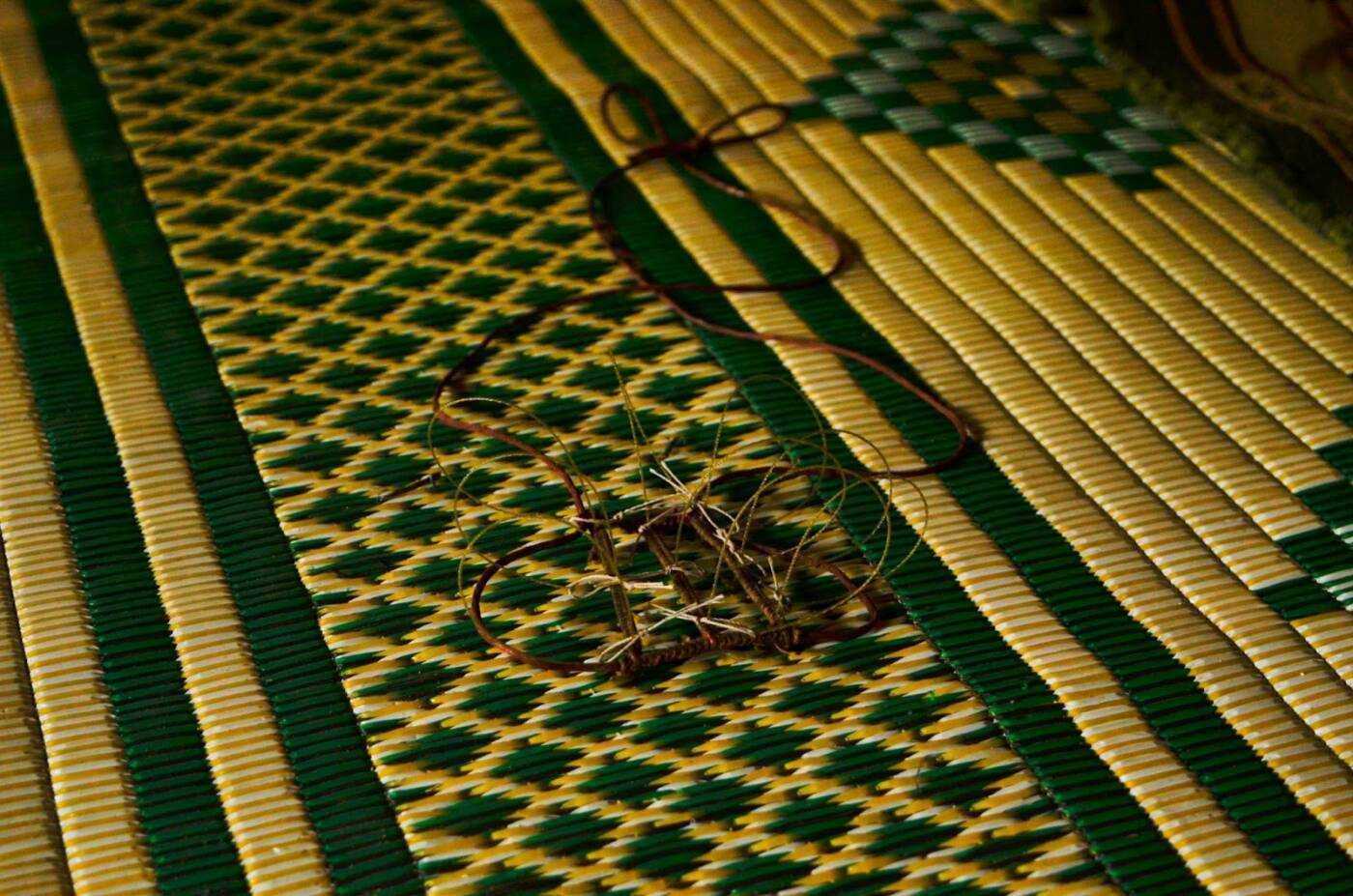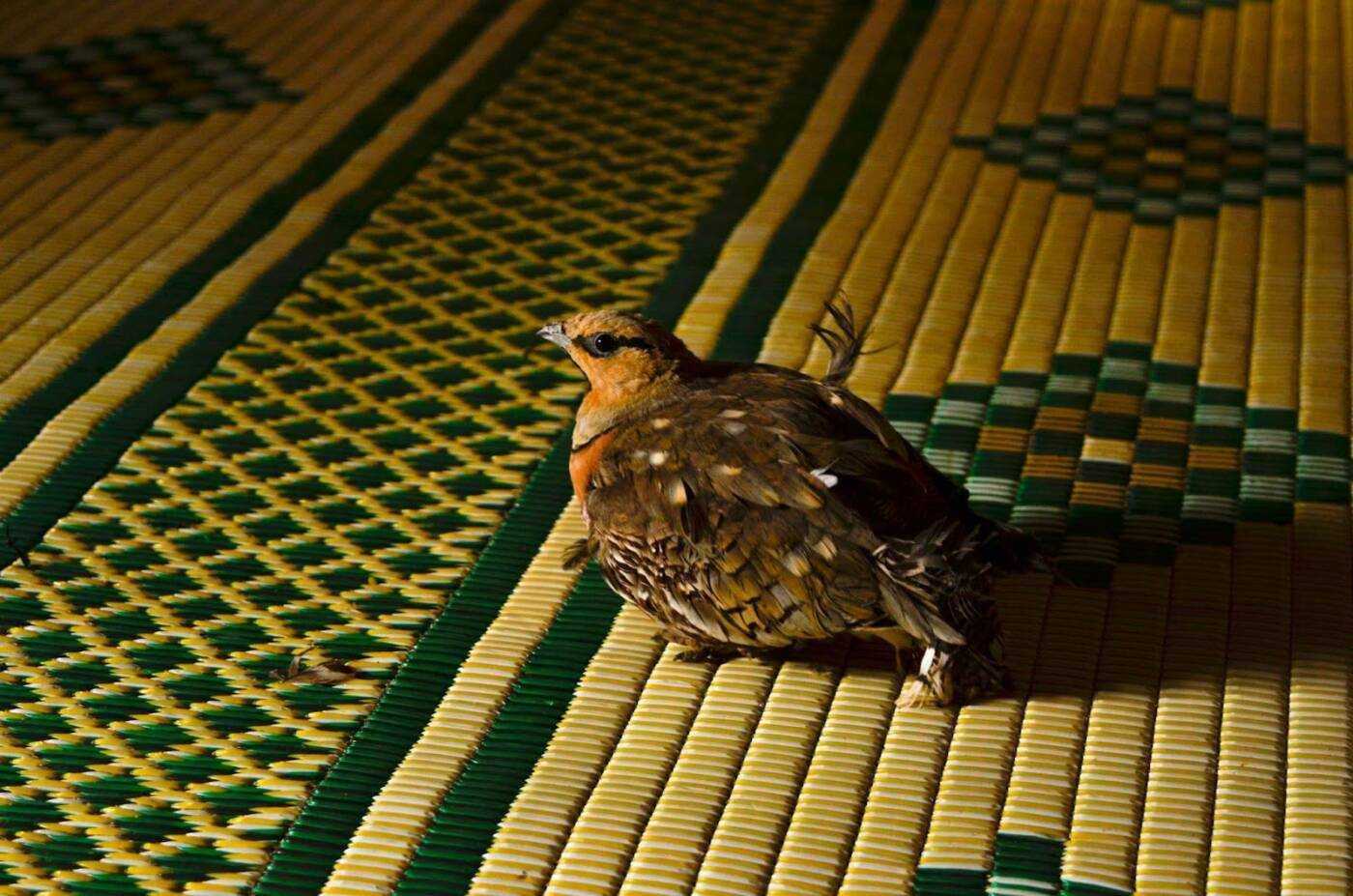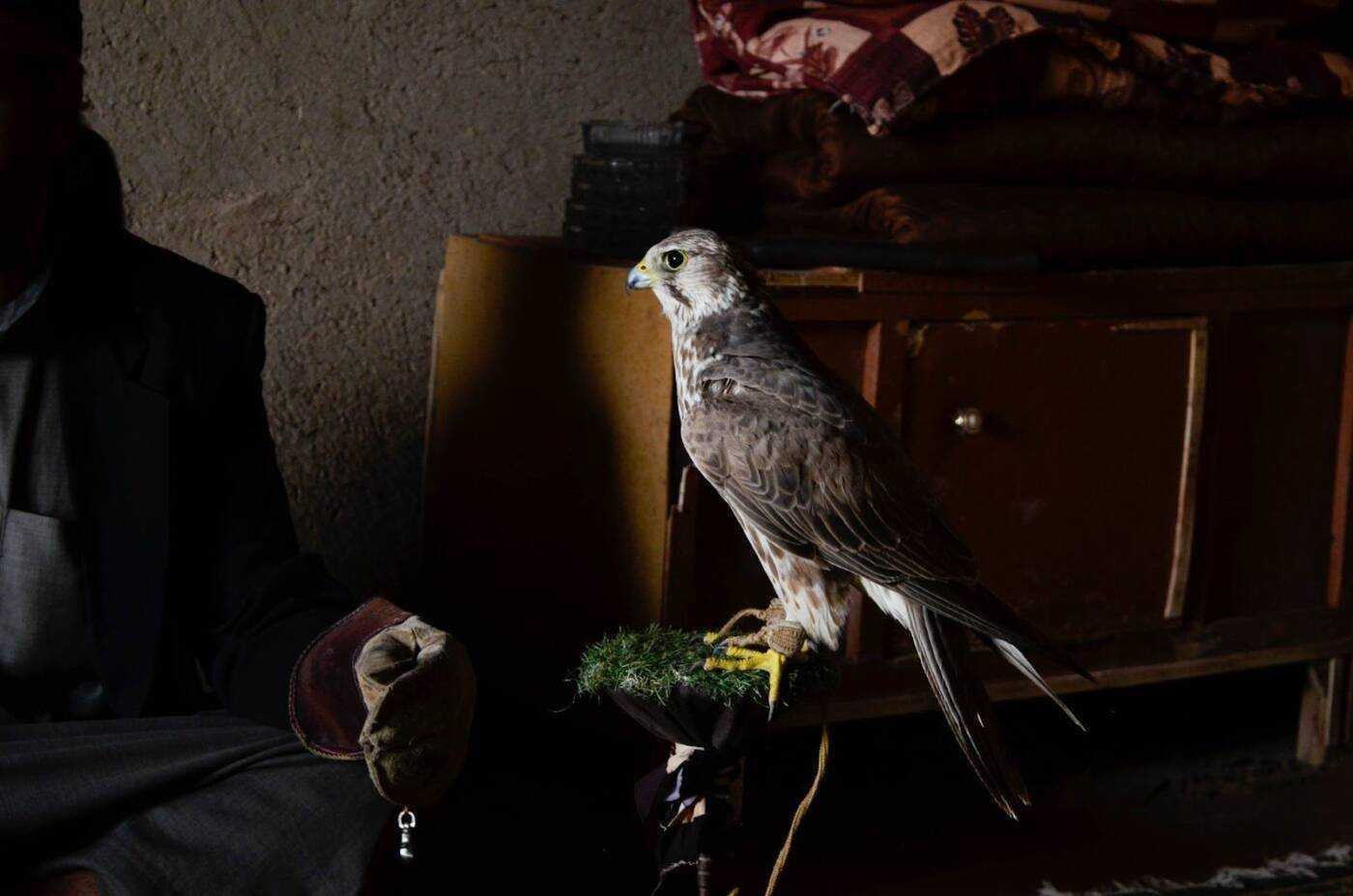Kings of the Syrian sky: Falcon trafficking soars in northeastern Syria
Once a traditional hobby practiced by a few hunters, falcon trapping is now a booming business in Syria. After 12 years of war and economic crisis, the trade is more popular than ever, and hunters are willing to take growing risks to catch the birds.
28 June 2023
Al-TASH — One overcast day in early April, a strange bird stood near the entrance of a low-lying mud house in al-Tash, an Arab village deep in the countryside of Syria’s northeastern Hasakah province near the border with Iraq.
Feet tied to a small wooden pole, eyes covered by a small leather hood, the bird stood perfectly still and silent. With its sharp beak and talons, it was unlike any bird one might expect to see near human dwellings.
The bird, a young lanner falcon, was caught on the outskirts of the village a few days earlier by Abu Saddam, a sturdy Syrian hunter in his late fifties. Dragged down to earth from his kingdom in the sky, caged in darkness by the hood, the falcon clung helplessly to his stand as his jailer carried him inside to an audience: half a dozen men from the village, all wearing traditional keffiyehs and long kaftans.
Beaming with pride, Abu Saddam sat among the guests in his modest sitting room, shielded by thick walls of bare mud brick. “The happiness of catching a falcon is impossible to describe,” he told Syria Direct. This species is only worth a few hundred dollars, but others sell for much more. “Sometimes we catch another kind, which we call shaheen, worth $10,000 or more.”
Catching a falcon is akin to stumbling across a nugget of gold.
The lucky catch was a blessing for Abu Saddam, who, like everyone else in al-Tash, depends year-round on the inconsistent income his family earns from rainfed farming and livestock rearing. It was not the first time the sky sent him good fortune: since he began hunting in the early 2000s, Abu Saddam claims to have trapped at least a dozen falcons. He keeps a portrait of three favorites in a picture that hangs by the entrance of his house.
Although Abu Saddam is recognized by his peers as a talented hunter, he is far from the only one in the area to occasionally earn an unexpected income from catching a falcon. Every fall, dozens—perhaps hundreds—of migratory saker and peregrine falcons are caught in Syria’s eastern desert, the Badia, by parties of local hunters. Trappers spend weeks in the wilderness, hoping to catch the mighty birds as they cross the region, migrating south from nesting grounds in Europe and Asia to warmer wintering grounds in Africa. Resident lanner and barbary falcons are also trapped.
Birds once worth a few hundred thousand Syrian pounds now sell for millions.
The hunting craze is largely fueled by the high price of falcons, which are smuggled through neighboring countries and sold for tens of thousands of dollars in Gulf countries, where falconry—hunting with a trained falcon—is a traditional sport. But in recent decades, the practice has taken a growing toll on falcon species, some of which—like the saker—are threatened with extinction.
Falcons are protected by international agreements that prohibit their sale, and falcon trapping is officially outlawed in Syria. But since the start of the war, rampant lawlessness, the country’s partition into zones controlled by competing authorities, and economic hardship have all fueled falcons’ popularity. Seen as treasures fallen from the sky, these birds are sought after by a growing number of amateur hunters, who also cherish the hunt as a way to reconnect with the wild in a country paralyzed by war and sanctions.
To keep this tentacular transnational business alive, complex networks of trappers, traffickers and buyers spanning Syria and beyond work together, despite the war, to smuggle birds from the remote desert corners where they are caught to their final buyers in the Gulf.

Abu Saddam keeps pictures of some of the falcons he has caught in his house in al-Tash, northeastern Syria, 12/4/2023 (Lyse Mauvais/Syria Direct)
‘Addicted’ to the hunt
Stretching out across most of eastern Syria, the arid Badia is the heart of Syria’s falcon-trapping frenzy. The sparsely vegetated, semi-arid plains that fringe the desert on all sides are also prime ground for the hunt. There, falcon trappers can spot their prey from afar and follow them over long distances, waiting for their chance.
During the trapping season, which runs from late August to November, hunters go out in parties of four or five for days, weeks and sometimes months at a time, camping in remote, undisturbed corners of the desert. When a bird is spotted, trappers release a pigeon or quail carrying a small trap on its back made of closely-looped iron wire. When a hungry raptor descends on the bait, its talons become entangled in the trap, unable to break loose.

An inexpensive trap made of looped iron wire, which is tied to the back of a live bird used as bait during falcon hunts, 12/14/2023. (Lyse Mauvais/Syria Direct)
Adrenaline kicks in. Driving their pickup at full speed through rough open terrain, trappers try not to lose sight of the falcon until it lands, exhausted by the weight of its prey. The chase can last for several kilometers before they finally manage to throw a net over the grounded bird.
As the net falls, hunters break into screams of joy, some pulling out their phones to record the life-changing moment. Catching a falcon is akin to stumbling across a nugget of gold. Wild-caught falcons are extremely sought after in the Gulf for falconry. Syrian trappers can expect to earn anywhere between $1,000 and $30,000 per bird, depending on its species, weight and height—an amount that is shared among all members of the party.
“Hunting has been our shared passion for hundreds of years.” ~ Hajji Muhammad Abu Jassem
Such a fortune can change the fate of a family in Syria, which has been grappling with an extreme economic crisis since the start of the war. Falcons are sold in dollars, the value of which is 400 times higher against the Syrian pound today than in 2015. Birds once worth a few hundred thousand Syrian pounds now sell for millions.
But for hunters, it is not only about the money. “It’s in our blood,” Abu Saddam, the trapper from al-Tash, explained. His guests all nodded enthusiastically. “We can’t quit this hobby. Even if I couldn’t sell these birds, I would still go out there and hunt for the very special thrill of it.”
It is a thrill that sometimes justifies risking one’s life: The hunt can take trappers dangerously close to the borders with Iraq and Turkey, to the fringes of fields mined during the war. “There are dangerous places to hunt in,” Abu Saddam acknowledged. “We rely on soldiers at the checkpoints to warn us about the mines.”
Trapping in the open
Like Abu Saddam, Hajji Muhammad Abu Jassem describes his relationship to falcons as an “addiction.” But he believes that it is, above all, an important tradition that unites all men in the region.
“Northeastern Syria is home to a huge diversity of people, including Assyrians, Syriacs, Kurds, Arabs….Hunting has been our shared passion for hundreds of years,” the seasoned hunter told Syria Direct. “This is our heritage, passed down from father to son.” Trappers say women practically never hunt, although some recall instances of wives accompanying their husbands on hunting parties.
Abu Jassem’s passion for falcon trapping began 45 years ago, and took him all the way to Azerbaijan and Turkey in search of new hunting grounds. Still, for much of his hunting career he never dreamed of trapping openly—much less of becoming a spokesperson for local hunters, as he is today.
Falcon trapping is officially outlawed in Syria, which is a party to the Convention on International Trade in Endangered Species (CITES) regulating the international trade in threatened animals and plants. Countries belonging to CITES agreed to ban the sale of most wild falcons in the 1980s. Before 2011, trapping was punished under Syrian law by a fine of up to SYP 250 (around $5 at the time) and up to two months in jail, although penalties were often not imposed and law enforcement was weak.
After 12 years of war, the legal facade that the Syrian state kept up for years by sporadically cracking down on falcon hunters collapsed almost entirely.
But after 12 years of war, the legal facade that the Syrian state kept up for years by sporadically cracking down on falcon hunters collapsed almost entirely. Today, state institutions are in shambles, and much of the country is beyond their reach.
Syria’s northeast is controlled by the Autonomous Administration of North and East Syria (AANES), a de facto government led by a coalition of Kurdish, Arab and Assyrian political parties. In this part of the country, war has ushered in a golden age for hunters: Falcon trapping is now completely tolerated by local authorities, who are focused on keeping the region afloat economically, not cracking down on poaching.
“There are absolutely no laws under the AANES forbidding falcon trapping. We help hunters register themselves because we want the sector to be organized,” Dejwar Muhammad, the director of the Livestock Committee of the AANES Agriculture Board in Qamishli, told Syria Direct. Hunting is occasionally banned in certain areas, mostly for security reasons, he added.
Owing to these political reconfigurations, life has changed drastically for Abu Jassem. He is now the head of Qamishli’s Union of Falcon Hunters, which he founded in 2019. He works from an office in downtown Qamishli, hosted by the larger AANES-affiliated Farmers’ Union, and no longer hides from local authorities while hunting in the wild.
On the contrary, his role is to “facilitate the work of falcon hunters and coordinate between them and local authorities,” Abu Jassem said. He is not alone. “Every locality in the region has its own association of migratory falcon hunters,” he added enthusiastically.
The AANES is not concerned about the environmental impact of its new approach. “In the days of the regime,” Muhammad added, “they weren’t issuing licenses for falcon trapping, but it wasn’t really outlawed either, because as you know it’s impossible to put guards everywhere and control what people do in the countryside.”
Soaring prices
Even as law enforcement to protect migratory raptors has diminished, interest in the falcon business is growing across Syria, fed by a rapidly deteriorating economic situation since the start of the war.
“A lot of new people started trapping over the past two or three years,” Abu Saddam, the hunter from al-Tash, said. “People see these birds sell for a good price, so they try their luck. Even people who have zero experience hunting or trapping try to join hunting parties.”
Rising interest in the hunt, at least in northeastern Syria, is facilitated by the transformation of the legal landscape and the emergence of hunters’ unions, which now issue licenses to falcon trappers. The licenses, which cost around SYP 4,000 (around $0.50 according to the May exchange rate of 8,000 SYP to the dollar) and are valid for a year, help hunters pass through checkpoints with their ammunition and bait.
“Thanks to these cards, you can carry around your rifles, your traps and your pigeons and no one will arrest you,” Abu Saddam said. “It wasn’t like that before the war. People who went hunting were scared of having their equipment or rifle confiscated.”
Introduced in 2019 when the first falcon trappers’ union was created in Qamishli, these licenses have skyrocketed in popularity over the past three hunting seasons, pointing to growing public interest in falcon trapping. The number of annual licenses issued by the Qamishli union for the entire province of Hasakah ballooned from around 60 in 2019 to more than 900 in 2022, according to Abu Jassem, who heads the union.
Falcon trapping grew into a sprawling business involving hundreds of trappers and traders across several countries of the Middle East.
The impact of falcon trapping has likely been further compounded since 2011 by increased access to ammunition and weapons, although it is impossible to measure since there is no data on the number of birds caught and smuggled out of Syria each year.
Hunters themselves claim that their numbers have increased, and that trapping is easier overall. “We have greater freedom, so more hunters are going out. It was more difficult before. We couldn’t always go hunting, some areas were hard to reach,” Abu Jassem said. “With time, it’s become much easier. You can go out into the desert and hunt with a simple motorbike.”
The trade in wild falcons is also flourishing, even though some of Syria’s best trapping zones are now separated from major cities by conflict lines. Historical trading networks have been reconfigured somewhat, but persist.
“A lot of new people started trapping over the past two or three years.” ~ Abu Saddam
Before the war, falcon traders were mostly based in the city of Rahiba, on the outskirts of Damascus. Officially, they were only allowed to trade in wild falcons within Syria, since exports were officially outlawed in accordance with CITES. Still, hundreds of registered traders operated out of the city, and most had a hand in illicitly smuggling falcons to Gulf buyers.
That network of traders still exists, and today many of the birds caught in northeastern Syria, which is not controlled by the Syrian government, are still sold to them. The birds are first sent from AANES areas to regime territory through internal crossing points within Syria, then smuggled out of the country—either by plane via Lebanon, or overland across the southern Syrian desert and through Jordan.
But new routes have also developed, two traders and two hunters told Syria Direct. Some birds are sent directly to the autonomous Kurdistan Region of Iraq (KRI), which borders AANES-controlled parts of Syria, through the Fishkhabour-Semalka border crossing. The living cargo crosses “without difficulty and in a legal manner” through the crossing, one trader said, although “export fees” have to be paid. From then on, the birds are likely sent overland across Iraq to reach their final buyers in the Gulf.
“What probably happened is that someone caught a bird, sold it to someone from the Gulf, and made a little profit. It became a business.” ~ Abu Saddam
Iraq is also a party to CITES, and hunting and trading in falcons is prohibited in Iraqi Kurdistan, but local authorities say a lack of training and funding is to blame for the treaty’s low enforcement. “We are trying to crack down on wildlife trafficking, but the airports and borders here don’t have the equipment needed to detect wildlife products being taken through illegally,” an official of the KRI Board of Environment, the entity in charge of implementing CITES in the autonomous province, told Syria Direct.
‘It’s a business’
Syrian hunters often describe their hobby as a tradition, but its current scale, scope and impact is far from traditional. For centuries, falconry was practiced by various elites and by some local hunters, but affected a limited number of birds, which were generally released after a few hunting seasons.
But over recent decades, falcon trapping grew into a sprawling business involving hundreds of trappers and traders across several countries of the Middle East and Central Asia. Raptors are now sought after not just by falconers, but also by wealthy elites in the Gulf who prize them as status symbols. Some own collections of dozens of birds, which they do not intend to release into the wild.
Syrian trappers themselves acknowledge the shift that took place over the last century.
“In the old days, we didn’t catch falcons to sell them. We caught them for ourselves, we trained them and taught them how to hunt,” Abu Saddam said. But rising wealth in the Gulf, largely fueled by the growth of the oil sector in the 1980s, allowed a growing number of falconers to travel with their birds to other hunting grounds in the region and build connections abroad with local hunters. From these exchanges, an international business emerged.

A sandgrouse used as live bait by falcon hunters, 12/4/2023. (Lyse Mauvais/Syria Direct)
“I wasn’t there of course. It was in the days of my father and my grandfather,” Abu Saddam said. “But what probably happened is that someone caught a bird, sold it to someone from the Gulf, and made a little profit. It became a business.”
In the years that followed, transnational networks of buyers and sellers developed across the region. Specialized middlemen emerged in Syria. They bought the birds caught by local trappers on behalf of larger traders and buyers in the Gulf, negotiating their prices over the phone. Meanwhile, a growing number of people picked up trapping techniques and became regular hunters, like Abu Saddam and many of his neighbors.
As catching falcons grew more lucrative, Syrian trappers began exploring new hunting grounds, not only in Syria but abroad: in Azerbaijan, Mongolia, Iran and Russia. So many Syrian poachers traveled to Russia and Central Asia in the 1980s that falcon-trappers became known as “Syrians” in Russian.
Today, this hunting boom is taking a toll on certain species of falcons, which are now endangered, like the saker falcon. Others, such as lanner falcons, are not yet globally threatened, but are declining in the region, in part due to overhunting. Trappers themselves notice changes on the ground. “We used to catch sinjari falcons more easily, but now they’ve become a rarity,” Abu Saddam said, referring to a local sub-species of saker falcons.
“We used to have 25 people catching 25 birds in Hasakah province. Now we are 500, and we catch 200 birds.” ~ Abu Jassem
Others do not notice a decline in bird populations, although this has been documented by ornithologists. “On the contrary, in Syria we see more birds than before, since there are more hunters, and therefore more people looking for birds,” Abu Jassem said. “We used to have 25 people catching 25 birds in Hasakah province. Now we are 500, and we catch 200 birds.”
In Syria and beyond, the trade’s rising popularity drives growing competition between hunters. Their practices have expanded in response, reaching new areas and sometimes new species. Some inexperienced hunters trap any kind of raptors, including eagles, buzzards and vultures, confusing them with valuable falcons.
“Trappers have become very greedy, and they go after anything they can catch,” said Nashat Hamidan, a conservationist who helped establish a rehabilitation center for rescued raptors managed by the Jordanian Royal Society for the Conservation of Nature (RSCN).“That’s partly why falcons have become critically endangered. Wild populations are dwindling,” he said.
Looking up to the Syrian sky, which has filled with birds every spring and every fall for as long as he can remember, Abu Jassem sees no reason to worry. For now, there are still enough falcons in Syria to fuel the dreams of hundreds of hunters stranded in its impoverished countryside, eager for a chance to reconnect with nature, enjoy the company of fellow hunters and practice a beloved hobby.
But as more and more people pick up the trade, the impact on raptors grows. One day, the mighty birds—symbols of the desert and kings of the Syrian sky—may be as rare as gold in the Badia.
This story was produced with support from a grant from the Internews Earth Journalism Network.







